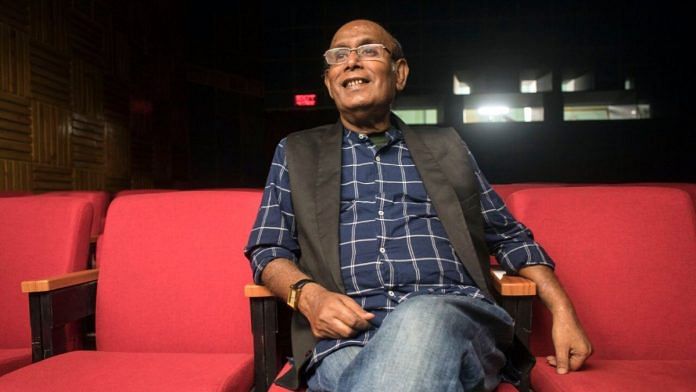At a time when Satyajit Ray and Mrinal Sen were rising as giants, not just in Bengali cinema, but across India, 32-year-old economics professor Buddhadeb Dasgupta decided to quit his job and pursue what he had always loved—filmmaking.
Despite the opposition from his father, a doctor with the Indian Railways, he was finally choosing his own path, much like the characters in his films. His first, Dooratwa (1978), was an exploration of the Naxal movement in Kolkata through the life of a liberal political science professor. Far from the shadows of Sen and Ray in a “world beyond reality”, Dasgupta’s legacy was taking shape.
“Put some dreams, some magic, some reality into a glass and shake it. That’s my cinema,” the Golden Bear, Golden Lion and Hugo award nominee later described in an interview.
Also Read: Ismail Merchant, the filmmaker who gave the world a new lens to look at Indians
Cinema of his own
While he may have chosen to study and later teach economics, Dasgupta was always a storyteller. He published several books of poetry in Bengali like Govir Araley, Coffin Kimba Suitcase, and Roboter Gaan alongside the 18 feature films he made. He started his career with a 10-minute documentary The Continent of Love (1968).
His initial films were stories steeped in social realism and were mostly set in and around Kolkata. Dooratwa (1978), Grihajuddha (1982), and Andhi Gali (1984), a loose trilogy, focussed on The Naxalite movement and its failure. However, Dasgupta differed from the likes of Sen, Ray and even Ritwik Ghatak in his use of magic realism.
His 1993 film Charachar marked a shift from the gritty realism from his films to otherworldly magic realism.
In a way, he was a part of the parallel cinema, but his lens was different. In an interview with the Scroll.in he revealed: “I like seeing realistic cinema, but I don’t feel like making them.” Dasgupta combined visual poetry with socially relevant themes to create his unique brand of films, which garnered 12 national awards.
Also Read: K Balachander, the filmmaker Rajinikanth, Kamal Haasan & Sridevi owe their careers to
Humans of Buddhadeb Dasgupta’s films
Buddhadeb Dasgupta created protagonists who were misfits with aspirations that the society failed to comprehend. In Bagh Bahadur (1989), Ghunuram, in a career-best performance by Pawan Malhotra, is a behrupiya (impersonator) who plays the role of bagh or tiger in the local form of rural Bengal entertainment. Ghunuram is also a migrant labourer who refuses to give up in the face of a new travelling circus that has a real captured leopard to perform.
“Both Salim Langde and Bagh Bahadur won National Film Awards in 1990. Whatever I am today is because of God’s grace and these two films,” Malhotra said in an interview. Bagh Bahadur is one of the only two Hindi films that Dasgupta made and is also his most widely known.
“I like people who are not materialistic, who are emotional and sensitive, who get lost while talking. I don’t like people who are too practical, who figure out things quickly,” Dasgupta said in an interview.
In Charachar (1993), he created Lakha, played by Ranjit Kapoor, who is the proverbial ‘bird man’. Despite belonging to a family of bird catchers, Lakhinder does not quite like his profession. He would rather they fly free, even as his ‘worldly’ life is disrupted because he does not sell enough birds. The film went on to become one of the two nominations Dasgupta received for the Golden Bear at the Berlin International Film Festival. The second one was for Phera (1998).
In Mondo Meyer Upakhyan (2002), Dasgupta moves from the realm of magic realism to surrealism. Set in a brothel in the middle of nowhere, the film is shot in Dasgupta’s birthplace, Purulia. One cannot distinguish reality from dreams in this film, which also has a cat and a donkey as important characters. The film looks at the story of Lati, played by Samanta Das, who runs away from the brothel to escape a life similar to her mother’s.
On 27 May 2008, he was honoured with the lifetime achievement award at the Spain International Film Festival in Madrid.
In Buddhadeb Dasgupta’s last film, Anwar Ka Ajab Kissa, which was released in 2020, seven years after it was completed, Nawazuddin Siddiqui plays a private detective. The film is an exploration of the two realms inhabited by Anwar—hope and hopelessness. With a brilliant performance by Siddiqui and a brief cameo by Pankaj Tripathi, the film is a typical Dasgupta film, poetic and lingering on the edge of resilience in the face of darkness.
The filmmaker passed away on 10 June 2021, aged 77, in his hometown of Kolkata from kidney disease-related ailments he had been suffering for a long time.
(Edited by Srinjoy Dey)






